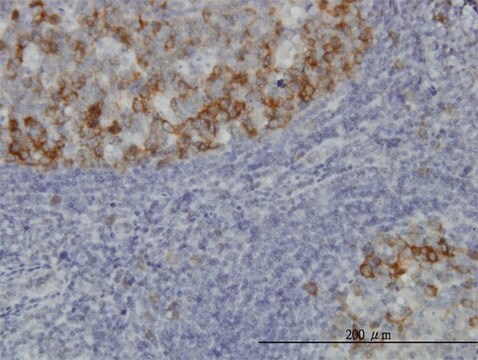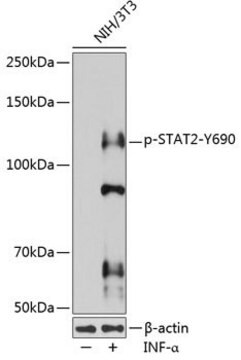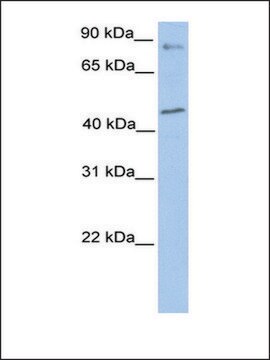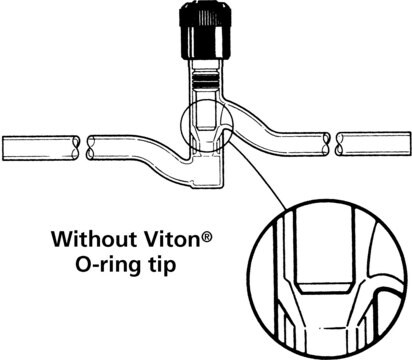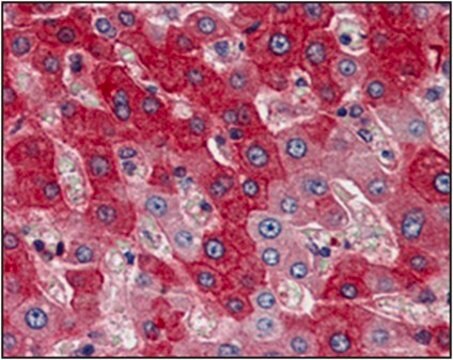MAB3612
Anti-BubR1 Antibody, clone 8G1
clone 8G1, Chemicon®, from mouse
Sign Into View Organizational & Contract Pricing
All Photos(2)
About This Item
UNSPSC Code:
12352203
eCl@ss:
32160702
NACRES:
NA.41
Recommended Products
biological source
mouse
Quality Level
antibody form
purified immunoglobulin
antibody product type
primary antibodies
clone
8G1, monoclonal
species reactivity
human
manufacturer/tradename
Chemicon®
technique(s)
immunocytochemistry: suitable
western blot: suitable
isotype
IgG1
NCBI accession no.
UniProt accession no.
shipped in
wet ice
target post-translational modification
unmodified
Gene Information
human ... BUB1B(701)
General description
The mitotic checkpoint prevents the resulting two daughter cells from having unequal numbers of chromosomes. This condition, known as aneuploidy, is present in almost all cancer cells and may be due to malfunctions in the mitotic checkpoint. BubR1 is a mitotic checkpoint kinase and has been implicated in the metaphase checkpoint control in mammalian cells.
Specificity
Recognizes human BubR1.
Immunogen
Recombinant human BubR1.
Application
Detect BubR1 with Anti-BubR1 Antibody, clone 8G1 (Mouse Monoclonal Antibody), that has been shown to work in WB, ICC.
Western blot using an ECL detection system. Reacts with the ~120 kDa BubR1 protein and higher bands due to hyperphosphorylations.
Immunocytochemistry: 1 μg/mL on tissue culture cells. Suggested fix is 3.5% PBS-buffered paraformaldehyde for 7 minutes. Permeabilization method is 0.2% Triton-X-100 after fixation. Suggested blocking buffer is 10 mM Tris, pH 7.5 with 150 mM NaCl with 0.1% BSA.
Optimal working dilutions must be determined by the end user.
Immunocytochemistry: 1 μg/mL on tissue culture cells. Suggested fix is 3.5% PBS-buffered paraformaldehyde for 7 minutes. Permeabilization method is 0.2% Triton-X-100 after fixation. Suggested blocking buffer is 10 mM Tris, pH 7.5 with 150 mM NaCl with 0.1% BSA.
Optimal working dilutions must be determined by the end user.
Physical form
Format: Purified
Other Notes
Concentration: Please refer to the Certificate of Analysis for the lot-specific concentration.
Legal Information
CHEMICON is a registered trademark of Merck KGaA, Darmstadt, Germany
Not finding the right product?
Try our Product Selector Tool.
Storage Class
10 - Combustible liquids
wgk_germany
WGK 2
flash_point_f
Not applicable
flash_point_c
Not applicable
Certificates of Analysis (COA)
Search for Certificates of Analysis (COA) by entering the products Lot/Batch Number. Lot and Batch Numbers can be found on a product’s label following the words ‘Lot’ or ‘Batch’.
Already Own This Product?
Find documentation for the products that you have recently purchased in the Document Library.
Heat shock protein inhibitors, 17-DMAG and KNK437, enhance arsenic trioxide-induced mitotic apoptosis.
Yi-Chen Wu,Wen-Yen Yen,Te-Chang Lee,Ling-Huei Yih
Toxicology and Applied Pharmacology null
Subcellular localization of the spindle proteins Aurora A, Mad2, and BUBR1 assessed by immunohistochemistry.
Burum-Auensen, E; De Angelis, PM; Schj?lberg, AR; Kravik, KL; Aure, M; Clausen, OP
The journal of histochemistry and cytochemistry : official journal of the Histochemistry Society null
Nageswara R Pulipati et al.
International journal of cancer, 129(3), 553-564 (2011-04-07)
km23-1 is a dynein light chain that was identified as a TGFβ receptor-interacting protein. To investigate whether km23-1 controls human ovarian carcinoma cell (HOCC) growth, we established a tet-off inducible expression system in SKOV-3 cells in which the expression of
David J Wynne et al.
Molecular biology of the cell, 27(22), 3395-3404 (2016-11-05)
The kinetochore is often depicted as having a disk-like architecture in which the outer layer of proteins, which engage microtubules and control checkpoint signaling, are built on a static inner layer directly linked to CENP-A chromatin. Here, applying three-dimensional (3D)
Emily A Foley et al.
Nature cell biology, 13(10), 1265-1271 (2011-08-30)
Error-free chromosome segregation depends on the precise regulation of phosphorylation to stabilize kinetochore-microtubule attachments (K-fibres) on sister chromatids that have attached to opposite spindle poles (bi-oriented). In many instances, phosphorylation correlates with K-fibre destabilization. Consistent with this, multiple kinases, including
Our team of scientists has experience in all areas of research including Life Science, Material Science, Chemical Synthesis, Chromatography, Analytical and many others.
Contact Technical Service